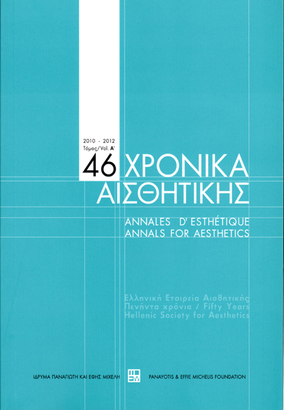Ξεπερνώντας το φόβο του κενού : παραστάσεις και εγκαταστάσεις του Yves Klein στα όρια της υλικότητας και της αναπαράστασης
Part of : Χρονικά αισθητικής : ετήσιον δελτίον της Ελληνικής Εταιρείας Αισθητικής ; Vol.46, No.Β, 2010, pages 301-315
Issue:
Pages:
301-315
Parallel Title:
Overcoming horror vacui : performances and installations of Yves Klein on the limits of materiality and representation
Section Title:
Εικαστικές Τέχνες - Κινηματογράφος / Visual Arts - Cinema
Author:
Abstract:
Towards the end of the nineteen fifties Yves Klein ventures into a set of artistic experiments with the void which are typical for his work as well as for the intellectual climate in France. In the 1958 Void installation in Iris Clert Gallery he exhibits the empty gallery rooms as an artwork, attempting, in a neodadaist gesture, to consider the artwork beyond its material confines and its representational status. Klein’s Void installation matches Martin Heidegger’s phenomenological conceptualization of things, during the early nineteen fifties, according to which things may not be isolated from their world, are not identical to material objects and need to be safeguarded against representational thinking that reigns in science and leads to their nuclear annihilation. In Zones of Immaterial Sensibility, 1959-1962, Klein challenges both artists’ and viewers’ conception of artwork based on material tangibility. He sells invisible but well demarcated areas of pictorial sensibility in the Parisian urban setting for gold which he then throws into the Seine river in a ritualistic way. Finally, in the 1961 Leap into the Void Klein realizes his dream of flying, jumping from his gallerist’s second floor of residence in a Parisian suburb into a fireguard net, held by his friends. The manipulated photographic documents of his “flight into space” do not show the net underneath and are widely circulated in his Dimanche newspaper in Paris. His montaged image of leap into the void is made to stand for all representational art, in general, which, in contrast to Renaissance crucifixions, explores levitation as the opposite of death. In all these void experiments Klein restages the Duchampian paradox, not however in order to disenchant art but with the explicit goal to give art back its aura, lost during the avant-garde experiments of the first half of the twentieth century. Artistic aura is considered as independent of representation and materiality and in this consideration the void plays an important, positive and strategic role, much in contrast to the past when the void was an anathema to be avoided by all means.
Subject:
Keywords:
εικαστικές τέχνες
Notes:
Το παρόν κείμενο βασίζεται σε ένα μέρος της διατριβής του συγγραφές και αποτελεί ανασύνταξη και επανεπεξεργασία του., Περιέχει εικόνες




